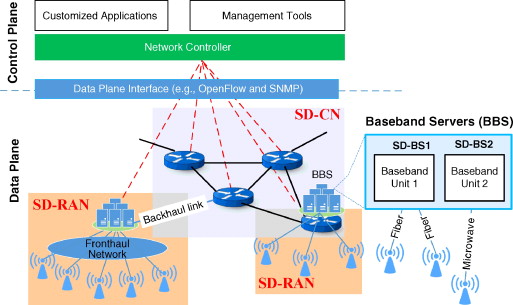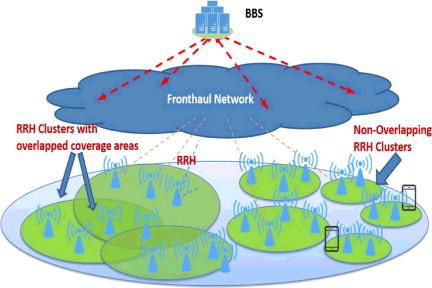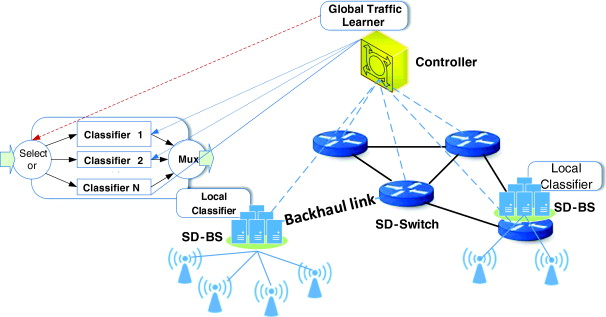School of Electrical and Computer Engineering Georgia Institute of Technology
This material is based upon work supported by the National Science Foundation under Grant Nos. 1547353 and 1763182.

Disclaimer: Any opinions, findings, and conclusions or recommendations expressed in this material are those of the author(s) and do not necessarily reflect the views of the National Science Foundation.
SoftAir: Towards to 5G Systems via a Software Defined Network Architecture
Intellectual Merits and Broader Impacts
The overall design objective of W-SDN is to enable essential features of next-generation wireless networks, including self-evolvability, fast-adaptability, multi-service mutli-technology convergence, maximum spectrum efficiency and low carbon footprints. The architecture of W-SDN consists of a data plane and a control plane. The data plane is an open, programmable, and virtualizable network forwarding infrastructure, which consists of software-defined radio access network (SD-RAN) and software-defined core network (SD-CN). The SD-RAN consists of a set of software-defined base stations (SD-BSs), while the SD-CN is composed of a collection of software-defined switches (SD-switches). The control plane mainly consists of two components: (1) network managing tools, and (2) customized applications of service providers or virtual network operators.
In this part of work, we design the architecture of W-SDN and study its core architectural principles, including the scalable design of software-defined radio access and core networks, as well as the seamless incorporation of network virtualization. We demonstrate how the proposed W-SDN architecture, by offering five properties including programmability, cooperativeness, virtualizability, visibility and openness, can achieve superior performance in terms of adaptability, evolvability, multi-service multi-technology convergence, and spectrum efficiency, all of which are essential features of next-generation wireless networks.

Based on the proposed W-SDN architecture, a set of essential management tools is developed to maximize the performance of W-SDN, which include capacity-optimal dynamic big base station formation, resource-efficient wireless virtualization algorithms, and distributed and collaborative traffic classification engines.
Cloud-based Crowd-augmented Spectrum Database: The W-SDN architecture enables us to develop novel cloud-based crowd-augmented spectrum databases, which fundamentally address the limitations (e.g., low accuracy and low spatial resolution) of the existing spectrum databases. In our case, the widely and densely deployed RRHs naturally constitute a large-scale sensor network for spectrum sensing. The BBU cloud, which has abundant processing power and memory space, can implement high performance, big (sensing) data-based, but computational-intensive spectrum mapping approaches. Moreover, the spatial resolution and accuracy of our cloud-based geo-location databases can be continuously and opportunistically augmented by the spectrum sensing data from the crowd of mobile white-spaces device (WSD) users.

Capacity-optimal dynamic big base station formation: The proposed SD-RAN design allows each SD-BS to associate with a large number of remote radio heads (RRHs). We introduce a generic optimization framework for dynamic SD-BS formation and its extension to high-density RRH deployments with an objective to maximize the spectral efficiency, while considering the specific cooperation costs in W-SDNs.

Resource-efficient wireless virtualization algorithms: Network virtualization capacity is essential to support Infrastructure-as-a-Service, thus enabling a wide range of emerging applications. Since wireless network resources are limited, we propose resource-efficient wireless network virtulization solutions. In particular, a utilization-optimal network hypervisor is proposed to maximize the global resource utilization, and a throughput-efficient wireless hypervisor is proposed to achieve the isolation of multiple virtual networks at each SD-BS.

Distributed and collaborative traffic classification engines: Without integrating advanced traffic engineering tools, improved spectrum efficiency does not lead to satisfied QoS for mobile users due to the highly bursty mobile data traffic emitted from diverse network applications with differentiated QoS demands. To this end, we propose a distributed and collaborative traffic classifier at SD-BS, which collaborates with a global traffic learner at the network controller to achieve fast, fine-grained and accurate traffic classification. With such traffic flow information, highly sophisticated and adaptive traffic engineering solutions can be adopted at both the BS and the network level.

Software-Defined Traffic Engineering
New traffic engineering solutions are designed to leverage the full potential of the W-SDN architecture. Specifically, collaborative scheduling and rerouting solutions proposed here are directly supported by the enabling tools.
Throughput-optimal collaborative scheduling: Each SD-BS can be optimally formed so that fine-grained coordination among a cluster of RRHs is enabled. Such promising feature along with the distributed traffic classifier on each SD-BS, for the first time, allows to perform throughput-optimal joint scheduling on a SD-BS. Throughput-optimal collaborative scheduling aims to optimally and collaboratively distribute network resources of a cluster of RRHs among their users based on the statistical properties of their traffic flows.

Software-defined mobility management: Mobility management faces significant new challenges in the next generation wireless systems, including minimum signaling overhead and QoS guarantees during handoff rerouting. To address these challenges, we propose a new software-defined mobility management framework for next generation wireless networks, which will leverage the multi-service multi-technology multi-network converged WSDN to offer low-cost, QoS-guaranteed, and seamless mobility services.

The validation of the proposed technology is viewed as a most important facet of this project. To validate the proposed W-SDN architecture, we leverage our expertise and prior experience in software-defined radios (SDRs) and experimental evaluation of wireless networks to develop a new experimental facility at UNCC as a proof of concept of the W-SDN architecture and its enabling algorithms. Upon such a physical testbed, the performance of the proposed W-SDN architecture and the associated solutions will be fully validated, facilitating practical implementations of our solutions.
The project is expected to pave the way for the development of innovative spectrum mapping, access, and sharing technologies based on the emerging cloud-RAN and SDN technologies. The resulted technologies can fundamentally enhance spectrum efficiency to meet the demands of fast-growing mobile traffic along with the rapidly-evolving and diverse network applications, thus providing uniform, ubiquitous network services for network users. The research is able to exploit and demonstrate the efficiency and effectiveness of exploiting emerging cloud and fog computing to perform delay-sensitive and computationally heavy wireless optimization schemes and signal processing algorithms.
Five Ph.D students are being educated in designing and developing the Cloud-RAN and SDN technologies. Two master students trained by this project have successfully be hired by SDN-related company, Arista Networks. The research results have been incorporated into the following classes, CS735 Data Communication Networks (Wichita State University), CS464 computer networks (Wichita State University), CS898 Cognitive Radio Networks (Wichita State University), ECE6610 Wireless Networks (Georgia Tech), ECE6615 Sensor Networks (Georgia Tech), and ECE4607 Mobile and Wireless Networks (Georgia Tech).